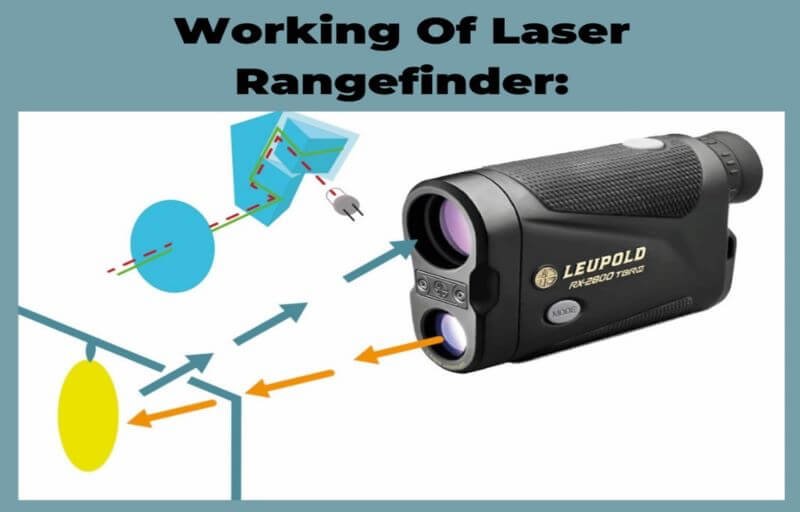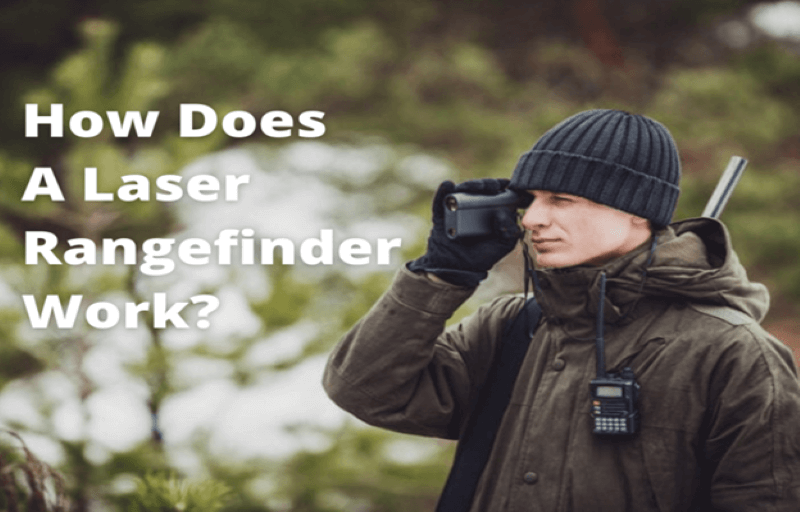We often rely on tools without ever considering how they function. While this is true for most instruments, others, such as a laser rangefinder, will perform better if you understand how they work. Now, do laser range finders work?
On the surface, taking a measurement using a rangefinder is straightforward; you have to aim at the object of interest. But how did that reading make its way onto your screen? If you understand how rangefinders make measurements, you may realize why various models give you different measures in different scenarios.
Knowing how a rangefinder works can help you pick the right one for your requirements and customize it to offer your desired information.
Do Laser Range finders Work?
What Is Laser Rangefinder?
Laser rangefinders are little devices that are equally important in the domain of optics, mainly when dealing with sports to begin. They operate on a simple principle: pressing the rangefinder’s button generates a laser beam.
After that, any erroneous shots that harmed your emotions will be long gone. It is a technical breakthrough created to alleviate the agony of missing a shot or failing to score a goal.
This compact portable gadget helps to measure distance accurately in microseconds. You may instantly adjust your trajectory, your aim, the power and force necessary for the strike, and even the possibility of your success.
How Does A Laser Rangefinder Work?
How a rangefinder works is straightforward. The gadget produces a laser beam. When the beam reaches the target, the signal bounces back to you. The rangefinder calculates the distance by measuring the time it takes for the beam to bounce back to you. The rangefinder then shows the computed result. Isn’t it simple?
Is it, however, always, correct? Since the rangefinder releases laser, the beam passes through a process that causes them to spread apart. The divergence, also known as dispersion, controls how “focused” the beam is when it reaches for your target.
Many factors contribute to errors caused by rangefinder mishandling. Many individuals unfamiliar with this notion are unaware that the laser beam becomes more prominent as the distance range increases.
The rule is straightforward: The greater the distance, the greater the beam divergence. When the light flashes, the beams tend to spread further as they move farther away from the tool, much like any other tool with light. It is also identical for the laser.
Assume you’re aiming at a deer from 400 yards away. Its beam divergence will likely be more accurate than a deer at a hundred yards. Precision works in this manner with beam divergence because as the dispersion of the beam increases, so does the region you are targeting with the rangefinder.
Few Things to Remember:
There are several excellent rangefinders available currently for your convenience. A few things mentioned below are essential before settling on the optimal course of action. These are extra details to understand how a rangefinder works.
Few main steps are involved in using your rangefinder: locating an object, focusing on it, transmitting the data, and evaluating it.
1) Spot the Target:
Suppose this is your primary reason for purchasing a rangefinder. In that case, you should look for high-quality lenses that provide precise magnification. Remember that it is challenging to target something you cannot see properly. Depending on what you want to utilize magnification for, you may wish to learn more about it.
2) Focus On the Target:
Many rangefinders provide information regarding their beam divergence. Perhaps you’re curious about how your equipment’s laser pulses change over time. Maybe you need to use some technical language here.
3) Be Wary of the Aperture Capacity:
A bigger aperture provides better return data, resulting in higher performance even at longer distances. It also provides more precise readings at close ranges.
4) Angle Matters Too:
On a golf course, there are instances when you must work with a slope. No worries, some rangefinders can compute angles for you! You need to discover the best ones for your golfing craze.
5) Check How It Analyses the Result:
The way each rangefinder interprets its readings differs. Some rangefinders are now “smarter” due to ongoing attempts to enhance technical breakthroughs. It is not to say that older models are unworthy of purchase. You only have to decide which ones are acceptable for what you want to utilize them for. Convenience purchasing may sometimes be considered wise buying.

What Are the Features of a Laser Rangefinder?
Now that you have a basic understanding of what rangefinders are, you can go on to learn about their extra hunting features. Many rangefinders have some magnification capabilities.
It’s pointless to use a rangefinder that can’t locate the target. Many feature magnification levels range from 4 to 10 times, allowing you to examine a field for marks like you would with binoculars.
To achieve a clean, non-blurred view, look for a rangefinder with lenses coated with a substance that reduces shine or glare on the eye. The magnification will render it worthless if the rangefinder is not built with high-quality lens.
Another phrase you should be familiar with is “beam divergence.” Essentially, this refers to how focused the laser beam is when it reaches the target.
Get a low-cost rangefinder for less than $50. The divergence will be pretty high, and it will be looking at the whole target you are aiming on, and it will not provide the best reading.
However, more costly rangefinders, which may cost a few hundreds of dollars, have more accuracy and can zero in on the specific region you are aiming to. It will enable you to measure the accurate distance and plan your shot.
Laser rangefinders may also detect speed rather than distance, so you will know precisely what bullet (or arrow) to employ for maximum effectiveness.
What Is a Laser Rangefinder Used For?
What can a laser rangefinder do with such precision? It may use for a variety of purposes:
• Hunting:
Laser rangefinders may significantly improve the accuracy of your rifle shots. Knowing your target’s exact distance to you allows you to home in on them more effectively. Some devices even consider elevation to help you fire more accurately. It’s ideal if you’re also hunting with a bow.
However, you must ensure that your rangefinder is rugged enough to function in the field where it may be cloudy or wet. Because you don’t always hunt on bright sunny days, it must also operate in low-light settings. A rangefinder is particularly important for targets that need you to fire from a greater distance.
• Long Distance Range Shooting:
It is a sport where you must know precisely how far your target is from you, and you can’t expect to strike the target if you estimate the distance by sight. When shooting over 400 yards, a rangefinder is essential for accuracy.
• Military:
Snipers often utilize rangefinders. Handheld military rangefinders may offer a variety of information, including the target’s inclination, size, and even speed. Cameras may be integrated with computers and can include thermal and night vision capabilities. You can use them on cars with a maximum range of several miles.
• Real Estate:
It provides a convenient method for the realtor and buyer to determine the size of the property. They can more precisely measure the lengths of the borders. Because of the price of a house offered per square foot, these accurate measurements might lead to the correct cost.
• Golf:
Many local competitions permit laser rangefinders, as long as the feature measures the distance from your target. Knowing the length of the goal in golf helps you choose the proper club for your next swing. Some units may even automatically concentrate on the flag to make things simpler for you.

• Forestry:
Forestry involves a great deal of measuring in terms of distance and tree height. The process is significantly more straightforward when using a laser rangefinder.
Because of rough and humid conditions, forestry rangefinders are more robust. The ones made expressly for forestry even include anti-leaf filters.
In certain situations, they operated with reflectors to provide the most precise distance measurement possible.
• Construction:
The rangefinder provides a safe and accurate means to measure distance in the construction business.
This sort of rangefinder should be both tough and waterproof. It is advantageous if the device can communicate with your laptop so that you can enter your measurements immediately into your building program.
• Airports:
This gadget lets you quickly examine and measure any problem with your runway and taxiway safety areas. You may explore the slope and height of your radio and lighting equipment. You may use your runway to calculate the distance between two items. A rangefinder makes examining an airport much simpler.
• Mining:
Precise blasting measures are necessary to ensure maximum mining production and worker safety. With the introduction of laser rangefinders, traditional techniques of getting such measurements are no longer appropriate.
• Modeling In 3D:
The device may send a variety of laser beams both horizontally and vertically. You may combine its readings with 3D software to produce the final design.
What Are the Benefits of Using Laser Rangefinders?
Laser rangefinders are the most practical and technologically advanced measurement equipment as compared to their optical and ultrasonic counterparts. Their main feature is that only one person can use them simultaneously, making for exact readings (+/- 1-5 mm per kilometer).
Optical rangefinders, which obtain accurate distance measurements on building sites and in broad open areas, need at least two individuals to utilize them simultaneously. As a result, adopting a laser rangefinder allows you to cut manpower needs while significantly speeding up measuring operations.
Laser rangefinders are also less vulnerable to measurement mistakes caused by poor tool placement and other operator faults. Using these instruments, you may measure time intervals, postpone measurements, add or subtract surfaces, and calculate volumes.
Laser rangefinders with advanced processors and excellent displays that show measurement data significantly boost their functionality, utility, and comfort of use.
Additional Resources
If you are looking for more tutorials, walkthroughs and troubleshooting about camping and enjoying the outdoors, here are some additional posts to check out:
Conclusion
Even though all laser rangefinders perform the same fundamental function, differences in how they collect measurements might result in significantly varied performance across models.
Reflections of laser light from a surface of interest serve as the basis for further measurements. The clock keeps track of how long it takes for the beams to return to the device, and the software analyses the data to present you with measurements.
Whether or not you range a deer depends on the quality of the beam and how the software interprets the data. If you think I forgot something or if you simply want to share a story, feel free to leave a comment below, but for now… Be Safe and Have Fun.!

